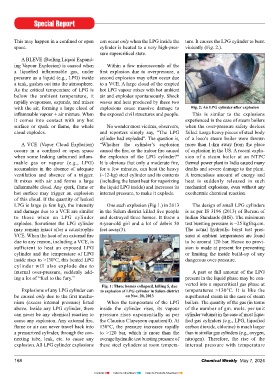Page 168 - CW E-Magazine (7-5-2024)
P. 168
Special Report
This may happen in a confi ned or open can occur only when the LPG inside the ture. It causes the LPG cylinder to burst
space. cylinder is heated to a very high-pres- violently (Fig. 2.).
sure supercritical state.
A BLEVE (Boiling Liquid Expand-
ing Vapour Explosion) is caused when Within a few microseconds of the
a liquefi ed infl ammable gas, under fi rst explosion due to overpressure, a
pressure as a liquid (e.g., LPG) inside second explosion may often occur due
a tank, gushes out into the atmosphere. to a VCE. A large cloud of the erupted
As the critical temperature of LPG is hot LPG vapour mixes with hot ambient
below the ambient temperature, it air and explodes spontaneously. Shock
rapidly evaporates, expands, and mixes waves and heat produced by these two
with the air, forming a large cloud of explosions cause massive damage to Fig. 2: An LPG cylinder after explosion
infl ammable vapour + air mixture. When the exposed civil structures and people. This is similar to the explosions
it comes into contact with any hot experienced in the case of steam boilers
surface or spark or fl ame, the whole No wonder most victims, observers, when the over-pressure safety devices
cloud explodes. and reporters simply say, “The LPG failed. Large heavy pieces of steel body
cylinder had exploded”. The question is, of a loco’s steam boiler were thrown
A VCE (Vapor Cloud Explosion) “Whether the cylinder’s explosion more than 1-km away from the place
occurs in a confi ned or open space caused the fi re; or the indoor fi re caused of explosion in the US. A recent explo-
when some leaking unburned infl am- the explosion of the LPG cylinder?” sion of a steam boiler at an NTPC
mable gas or vapour (e.g., LPG) It is obvious that only a moderate fi re, thermal power plant in India caused many
accumulates in the absence of adequate for a few minutes, can heat the heavy deaths and severe damage to the plant.
ventilation and absence of a trigger. (~12-kg) steel cylinder and its contents A tremendous amount of energy and
It mixes with air and forms a large (including the latent heat for vaporizing heat is suddenly released in such
infl ammable cloud. Any spark, fl ame or the liquid LPG inside) and increases its mechanical explosions, even without any
hot surface may trigger an explosion internal pressure, to make it explode. exothermic chemical reaction.
of this cloud. If the quantity of leaked
LPG is large (a few kg), the intensity One such explosion (Fig 1.) in 2013 The design of small LPG cylinders
and damage due to a VCE are similar in the Salem district killed fi ve people is as per IS 3196 (2013) of Bureau of
to those when an LPG cylinder and destroyed three homes. It threw a Indian Standards (BIS). The minimum
explodes. Sometimes the LPG cylinder 4-year-old girl and a lot of debris 50 test bursting pressure is ~25 kgf/sq.cm.
may remain intact after a catastrophic feet away(3). The actual hydraulic burst test pres-
VCE. When the heat of an external fi re sures at ambient temperatures are found
due to any reason, including a VCE, is to be around 120 bar. Hence no provi-
sufficient to heat an exposed LPG sion is made at present for preventing
cylinder and the temperature of LPG or limiting the inside build-up of any
inside rises to >130°C, this heated LPG dangerous over-pressure.
cylinder will also explode due to
internal over-pressure, suddenly add- A part or full amount of the LPG
ing a lot of “fuel to the fury.” present in the liquid phase may be con-
Fig. 1: Three homes collapsed, killing 5, due verted into a supercritical gas phase at
Explosions of any LPG cylinder can to explosion of LPG cylinder in Salem district temperatures >130°C. It is like the
be caused only due to the fi rst mecha- on Nov. 20, 2013 superheated steam in the case of steam
nism (excess internal pressure) listed When the temperature of the LPG boilers. The quantity of the gas (in terms
above. Inside any LPG cylinder, there inside the cylinder rises, its vapour of the number of gm. mols. per unit
can never be any chemical reaction to pressure rises exponentially as per cylinder volume) in the case of most lique-
cause any explosion. Any external fi re, the Clausius Clapeyron equation(4). At fi ed gas cylinders (e.g., LPG, liquefi ed
fl ame or air can never travel back into 130°C, the pressure increases rapidly carbon dioxide, chlorine) is much larger
a pressurized cylinder, through the con- to >120 bar, which is more than the than in similar gas cylinders (e.g., oxygen,
necting tube, leak, etc. to cause any average hydraulic test bursting pressure of nitrogen). Therefore, the rise of the
explosion. All LPG cylinder explosions these steel cylinders at room tempera- internal pressure with temperature
168 Chemical Weekly May 7, 2024
Contents Index to Advertisers Index to Products Advertised

